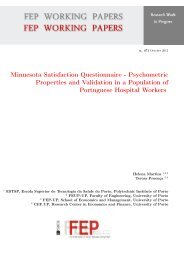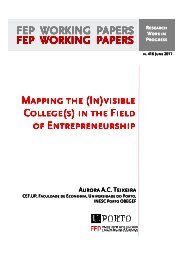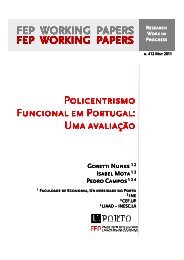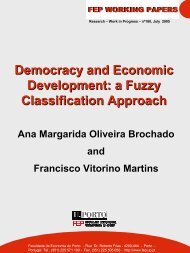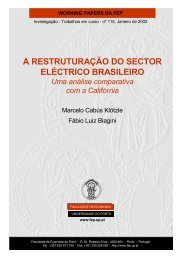FEP - Working Papers - Universidade do Porto
FEP - Working Papers - Universidade do Porto
FEP - Working Papers - Universidade do Porto
You also want an ePaper? Increase the reach of your titles
YUMPU automatically turns print PDFs into web optimized ePapers that Google loves.
with each firm selling one good, iR, with the objective of maximizing its individual profit,<br />
ΠiR. We exclude the possibility of concerted behavior between shops at a mall. Each shop<br />
chooses how much to charge for the product it sells, taking the remaining prices as given.<br />
3.1 Competition between a department store and a shopping<br />
mall<br />
We start by considering the case in which there is a department store located at x = 0 and<br />
a shopping mall located at x = 1. The department store chooses the prices of the n goods<br />
with the objective of maximizing its total profit ( � n<br />
i=1 ΠiL), while each of the shops at the<br />
mall seeks to maximize its individual profit (ΠiR).<br />
ΠL =<br />
The profit of the department store is given by: 8<br />
⎧<br />
⎨<br />
⎩<br />
�<br />
1<br />
PL<br />
2<br />
�<br />
˜xL<br />
� PR−PL + , p ∈ S1<br />
2t<br />
i∈IR piL + ˜xR<br />
�<br />
i∈IL piL, p ∈ S2 ∧ ˜xL ∈ [0, 1] ∧ ˜xR ∈ [0, 1] ∧ IL ∪ IR = I .<br />
The following result is instrumental. It states that if the department store sets profit-<br />
maximizing prices, there is “one stop shopping”.<br />
Lemma 1. Independently of the prices set at the right extreme, {piR} i∈I ∈ IR n +, the prices<br />
that maximize the profit of the department store, ΠL, are such that p ∈ S1.<br />
Proof. See Appendix.<br />
Proposition 1. In the case of competition between a department store and a shopping<br />
mall:<br />
(1) It is cheaper to buy the n goods at the department store than at the shopping mall:<br />
⎧<br />
⎨<br />
⎩<br />
PL = � n<br />
i=1 piL = 2n+1<br />
n+2 t<br />
PR = � n<br />
i=1 piR = 3n<br />
n+2 t<br />
8 The branches where ˜xL /∈ [0, 1] and ˜xR /∈ [0, 1] are omitted because they are irrelevant. The department<br />
store would never choose such prices. For the same reason, we also omit the case in which p ∈ S2 and<br />
∃i ∈ I : piL = piR > 0. The department store would gain by reducing piL infinitesimally.<br />
11<br />
,



